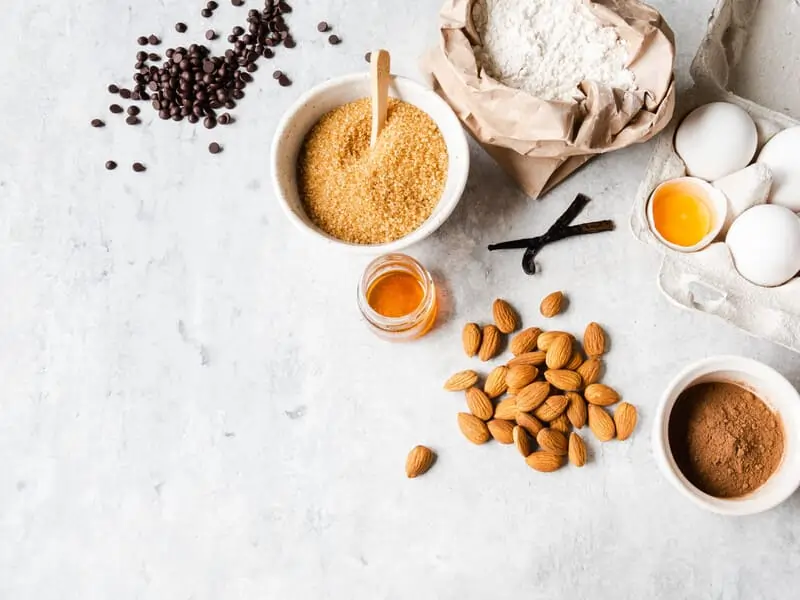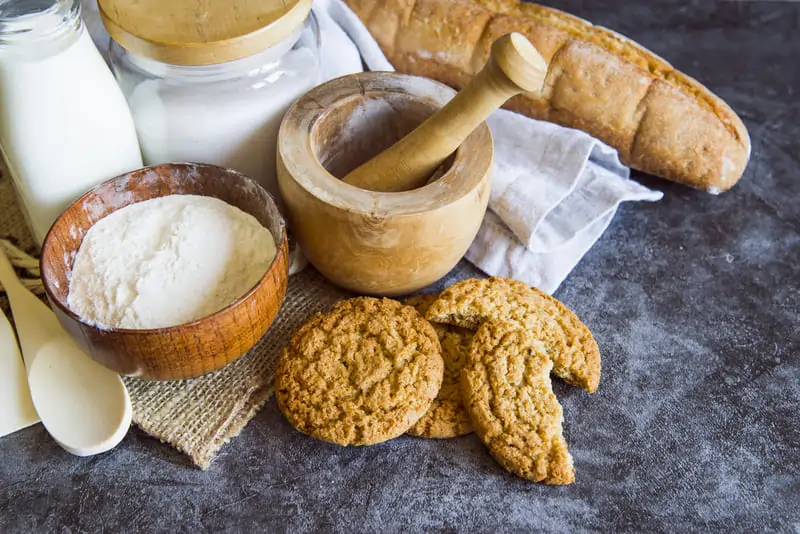Peanut butter cookies are a timeless favorite, loved for their rich flavor and versatility. Whether you’re making a simple 3-ingredient recipe or a classic variation with flour and brown sugar, these cookies are perfect for every occasion. Understanding the basic ingredients is key to achieving that ideal balance of flavor, texture, and ease.
For expert advice on how to troubleshoot common baking issues, visit troubleshooting tips for perfect baking. If you’re interested in vibrant and creative dessert ideas, check out how to make cookie color.
The Essential Ingredients for Peanut Butter Cookies

Peanut butter cookies are a classic treat, beloved for their nutty flavor and soft, chewy texture. At the heart of every recipe are a few essential ingredients that work together to create these delightful cookies. Let’s dive deeper into each ingredient, its role, and how you can tailor your cookies to suit your preferences. For more tips on working with unique ingredients, check out our guide to easy ingredient substitutions.
1. Peanut Butter: The Foundation
Peanut butter is the star ingredient, providing the cookies with their signature flavor and creamy consistency.
Types of Peanut Butter:
- Creamy Peanut Butter: Creates smooth, uniform cookies with no interruptions in texture. This is the standard choice for traditional recipes.
- Chunky Peanut Butter: Adds delightful bits of peanuts for a satisfying crunch in every bite.
- Natural Peanut Butter: Made from 100% peanuts, it offers a richer, more natural flavor. However, it may require extra mixing to incorporate separated oils, and the dough may be slightly softer.
Pro Tip: Experiment with other nut butters, like almond or cashew butter, for a creative twist on the classic recipe.
While peanut butter forms the base, sugar plays a key role in balancing flavors and creating the perfect texture.
2. Sugar: Sweetness and Structure
Sugar is essential not only for sweetening but also for contributing to the cookie’s texture and structure.
Common Sugar Options:
- Granulated Sugar: A classic choice that helps create a slightly crisp exterior, ideal for those who enjoy a crunchy texture.
- Brown Sugar: Adds moisture and a subtle caramel flavor, resulting in softer, chewier cookies.
- Coconut Sugar: A healthier, lower-glycemic option for those seeking a refined-sugar-free alternative. It imparts a slight molasses flavor similar to brown sugar.
Pro Tip: Combine granulated and brown sugar in a 1:1 ratio for cookies that are both crispy and chewy.
While sugar provides sweetness, eggs (or their substitutes) ensure the dough holds together and bakes evenly.
3. Eggs: The Binding Agent
Eggs are crucial for binding the ingredients together and providing structure to the dough.
Egg Alternatives for Vegan Cookies:
- Flaxseed Meal: Mix 1 tablespoon of flaxseed meal with 3 tablespoons of water and let it sit for 5 minutes. This creates a gel-like consistency that mimics eggs.
- Applesauce: Use 1/4 cup of unsweetened applesauce per egg. This substitute adds moisture and a subtle fruity flavor, making the cookies softer.
Pro Tip: If you prefer a richer flavor, consider adding one egg yolk in addition to the whole egg for extra chewiness.
While these three ingredients are non-negotiable, optional add-ins can elevate the flavor and balance the sweetness.
4. Optional Ingredients: Enhancing Flavor
Optional ingredients, such as vanilla extract and salt, add depth and nuance to peanut butter cookies.
- Vanilla Extract:
- Adds a subtle sweetness and aromatic richness.
- Use pure vanilla extract for the best flavor, or experiment with almond extract for a unique twist.
- Salt:
- Balances the sweetness and enhances the nutty flavor of peanut butter.
- A pinch of flaky sea salt on top of baked cookies adds texture and a gourmet touch.
Pro Tip: For a spiced variation, add a dash of cinnamon or nutmeg to the dough.
With these essential and optional ingredients in mind, you’re ready to create the perfect peanut butter cookies.
Tips for Success and Ingredient Substitutions
- Balancing Ingredients: If using natural peanut butter, slightly reduce the sugar to avoid overpowering the natural nuttiness.
- Making Healthier Versions: Swap sugar with natural sweeteners like maple syrup or stevia, but adjust the dough consistency as liquid sweeteners may make it softer.
- Customizing Texture: Adjust the baking time for a softer or crispier cookie.
For more inspiration on ingredient swaps and flavor variations, explore our easy ingredient substitutions guide and elevate your baking with confidence.
The Magic of Simplicity
The beauty of peanut butter cookies lies in their simplicity and versatility. By understanding the role of each ingredient, you can customize the recipe to match your taste preferences or dietary needs. With endless possibilities, peanut butter cookies remain a timeless favorite for all occasions! For more baking ideas, check out our creative cookie variations and start experimenting today.
Exploring Recipe Variations for Peanut Butter Cookies

The basic peanut butter cookie recipe is deliciously simple, but incorporating additional ingredients can elevate the flavor, texture, and presentation of your cookies. Whether you’re looking for a traditional enhancement or a bold new twist, there’s no shortage of options to explore. For even more creative ideas, take a look at our guide to banana bread cookies for unique snacks and discover exciting ways to experiment in the kitchen.
1. Traditional Enhancements
Adding classic baking ingredients can give your peanut butter cookies a more traditional texture and flavor profile.
Flour
- Why Add It?: While the basic recipe is naturally flourless, adding a small amount of flour creates a sturdier cookie with a more classic crumb.
- How to Incorporate: Add 1/4 to 1/2 cup of all-purpose or gluten-free flour to your dough. Adjust the consistency by reducing the sugar slightly if needed.
Pro Tip: For a nuttier flavor, try using almond or oat flour instead of traditional flour.
Beyond structure, the texture of your cookies can also benefit from leavening agents like baking soda.
Baking Soda
- Why Add It?: Baking soda introduces a slight rise to your cookies, resulting in a lighter texture and more defined crisscross patterns.
- How to Incorporate: Add 1/2 teaspoon of baking soda to your recipe. Ensure it’s evenly mixed into the dough to avoid uneven baking.
Pro Tip: For a chewier cookie, reduce the baking soda and bake for a slightly shorter time.
Once you’ve mastered traditional enhancements, it’s time to explore more creative additions to your peanut butter cookies.
2. Creative Additions
Taking your cookies to the next level often involves experimenting with unique flavors and textures. Here are some ideas to inspire you:
Chocolate Chips
- Why Add Them?: Chocolate and peanut butter are a timeless pairing, offering a balance of nutty richness and sweet decadence.
- How to Incorporate: Stir in 1/2 to 3/4 cup of chocolate chips (milk, dark, or white) before shaping the dough.
- Creative Twist: Use mini peanut butter cups or chopped chocolate bars for added variety.
Pro Tip: Press a few extra chips on top of each cookie before baking for a polished look.
While chocolate chips add indulgence, oats bring heartiness and texture to your cookies.
Oats
- Why Add Them?: Oats give cookies a chewy texture and make them feel more substantial, perfect for a snack or breakfast treat.
- How to Incorporate: Fold in 1/2 cup of rolled oats into your dough. For a smoother consistency, pulse the oats in a food processor before adding.
- Creative Twist: Add dried fruits like raisins or cranberries for a trail mix-inspired cookie.
Pro Tip: Combine oats with a sprinkle of cinnamon or nutmeg for an extra layer of flavor.
Speaking of spices, they’re another fantastic way to add warmth and depth to your peanut butter cookies.
Spices
- Why Add Them?: Spices like cinnamon and nutmeg complement the nutty flavor of peanut butter, creating a cozy, aromatic cookie.
- How to Incorporate: Add 1/2 teaspoon of ground cinnamon or a pinch of nutmeg to the dough.
- Creative Twist: Experiment with cardamom or ginger for a more unique flavor profile.
Pro Tip: Sprinkle spiced sugar (a mix of sugar and your chosen spice) on top of the cookies before baking for added texture and flavor.
Once you’ve mastered these creative variations, consider exploring even more unique snack ideas like banana bread cookies to broaden your baking repertoire.
More Creative Ideas to Explore
If you’re feeling adventurous, here are additional ways to transform your peanut butter cookies:
- Nutty Mix-Ins: Add chopped peanuts, almonds, or pecans for extra crunch.
- Jam Thumbprints: Create thumbprint cookies and fill them with strawberry, raspberry, or grape jam for a PB&J-inspired treat.
- Savory-Sweet Fusion: Add a sprinkle of flaky sea salt or smoked paprika for a gourmet twist.
Pro Tip: For a festive touch, drizzle melted chocolate or caramel over your cookies and top with sprinkles or edible glitter. Learn more decorating tips in our cookie decorating guide.
Unleash Your Creativity in the Kitchen
Peanut butter cookies are a classic for a reason, but with these enhancements and creative additions, you can turn them into something truly extraordinary. From the satisfying crunch of oats to the warm embrace of spices, the possibilities are endless. For more inspiration, check out our banana bread cookie guide and start experimenting with flavors that speak to you!
FAQs
What Type of Peanut Butter Works Best?
Both creamy and chunky peanut butter work well. Natural peanut butter requires extra mixing to avoid separation. For tips on how to work with natural ingredients, explore healthy ingredient substitutions.
Can I Make These Cookies Gluten-Free?
Yes, many recipes are naturally flourless, making them an excellent gluten-free option. For more gluten-free dessert ideas, check out simple gluten-free cookie recipes.
Are There Vegan Alternatives for Eggs?
Yes, substitutes like flaxseed meal or applesauce work great. Learn more about using flaxseed and other replacements in vegan baking techniques.
How Can I Store These Cookies?
Store in an airtight container at room temperature for up to a week or freeze for long-term storage. For additional storage tips and tricks, visit how to preserve baked goods.
Conclusion
Understanding the basic ingredients for peanut butter cookies is the first step to mastering this beloved treat. Whether you stick to the essentials or experiment with variations, these cookies are versatile enough to satisfy any craving.
For more inspiration, explore creative cookie designs and vibrant ideas or learn about ingredient adjustments for perfect baking. Let’s get baking!

